Historic Monuments of Ancient Kyoto (Kyoto, Uji and Otsu Cities)
| Historic Monuments of Ancient Kyoto (Kyoto, Uji and Otsu Cities)* | |
|---|---|
| UNESCO World Heritage Site | |
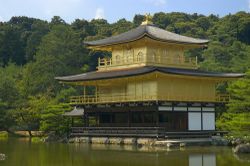 |
|
| State Party | |
| Type | Cultural |
| Criteria | ii, iv |
| Reference | 688 |
| Region** | Asia-Pacific |
| Inscription history | |
| Inscription | 1994 (18th Session) |
| * Name as inscribed on World Heritage List. ** Region as classified by UNESCO. |
|
The UNESCO World Heritage Site Historic Monuments of Ancient Kyoto (Kyoto, Uji and Otsu Cities) encompasses 17 locations in Japan. The locations are in three cities: Kyoto and Uji in Kyoto Prefecture; and Ōtsu in Shiga Prefecture. Of the monuments, 13 are Buddhist temples; 3 are Shinto shrines; and one is a castle. The properties include 38 buildings designated by the Japanese Government as National Treasures, 160 properties designated as Important Cultural Properties, 8 gardens designated as Special Places of Scenic Beauty, and 4 designated as Places of Scenic Beauty. UNESCO listed the site as World Heritage in 1994.
Contents |
Selection criteria
Kyoto has a substantial number of historic buildings, unlike other Japanese cities that lost buildings to foreign invasions and war; and has the largest concentration of designated Cultural Properties in Japan. The 17 properties of the World Heritage Site originate from a period between the 10th century and the 19th century, and each is representative of the period in which it was built. The historical importance of the Kyoto region was taken into account by the UNESCO in the selection process.[1]
List of locations
| Name | Type | Position | Picture |
|---|---|---|---|
| Kamowakeikazuchi Shrine (賀茂別雷神社 Kamo Wake-ikazuchi Jinja) or Kamigamo Shrine (上賀茂神社 Kamigamo Jinja) |
Shinto shrine | Kita-ku, Kyoto, | 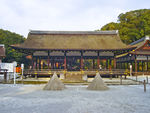 |
| Kamomioya Shrine ( 賀茂御祖神社 Kamo Mioya Jinja) or (Shimogamo Shrine (下賀茂神社 Shimogamo Jinja) | Shinto shrine | Sakyō-ku, Kyoto, | 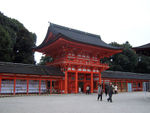 |
| Kyōōgokoku-ji (教王護国寺) (Tō-ji (東寺)) |
Shingon Buddhist temple | Minami-ku, Kyoto, | 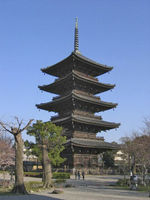 |
| Kiyomizu-dera (清水寺) | Independent Buddhist temple | Higashiyama-ku, Kyoto, | 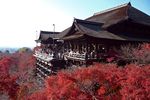 |
| Enryaku-ji (延暦寺) | Tendai Buddhist temple | Ōtsu, Shiga, |  |
| Daigo-ji (醍醐寺) | Shingon Buddhist temple | Fushimi-ku, Kyoto, |  |
| Ninna-ji (仁和寺) | Shingon Buddhist temple | Ukyō-ku, Kyoto, | 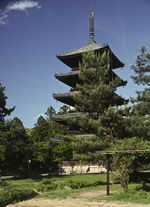 |
| Byōdō-in (平等院) | Buddhist temple jointly held by Jōdo shū and Tendai | Uji, Kyoto, |  |
| Ujigami Shrine (宇治上神社 Ujigami Jinja) | Shinto shrine | Uji, Kyoto, |  |
| Kōzan-ji (高山寺) | Shingon Buddhist temple of the Omuro school | Ukyō-ku, Kyoto, | 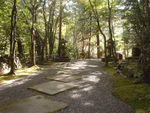 |
| Saihō-ji (西芳寺) or Koke-dera (苔寺) | Rinzai Zen Buddhist temple | Nishikyō-ku, Kyoto, | 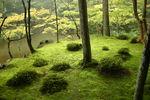 |
| Tenryū-ji (天龍寺) | Rinzai Zen Buddhist temple of the Tenryū school | Ukyō-ku, Kyoto, | 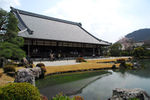 |
| Rokuon-ji (鹿苑寺) or Kinkaku-ji (金閣寺) | Rinzai Zen Buddhist temple | Kita-ku, Kyoto, | 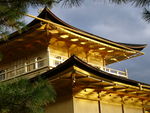 |
| Jishō-ji (慈照寺) or Ginkaku-ji (銀閣寺) | Rinzai Zen Buddhist temple | Sakyō-ku, Kyoto, | 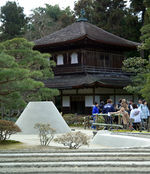 |
| Ryōan-ji (Shinjitai: 竜安寺, Kyūjitai: 龍安寺, The Temple of the Peaceful Dragon) | Rinzai Zen Buddhist temple of the Myōshinji school | Ukyō-ku, Kyoto, | 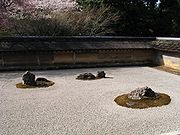 |
| Nishi Hongan-ji (西本願寺) | Jodo Shinshu Buddhist temple and world headquarters | Shimogyō-ku, Kyoto, |  |
| Nijō Castle (二条城 Nijō-jō) | Castle | Nakagyō-ku, Kyoto, |  |
See also
References
- ↑ ICOMOS (28 September 1993). Advisory Body Evaluation. http://whc.unesco.org/archive/advisory_body_evaluation/688.pdf. Retrieved 2009-04-10.
External links
- Historic Monuments of Ancient Kyoto (Kyoto, Uji and Otsu Cities) - UNESCO World Heritage Centre
- World Heritage Historic Monuments of Ancient Kyoto
- Welcome to Kyoto - World Heritage Map
|
|||||||||||||||||||||||||||||